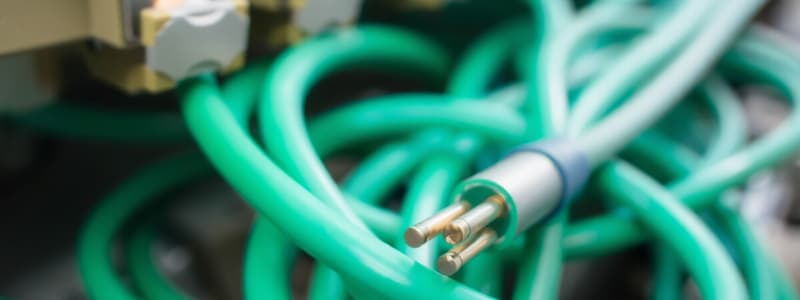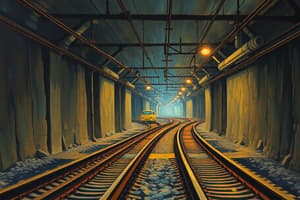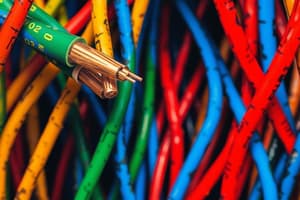Podcast
Questions and Answers
Match the following jointing kits with their corresponding cable types:
Match the following jointing kits with their corresponding cable types:
TSF-1 = Armoured PIJF cable TSF-2 = Armoured PIJF cable RTSF = Quad cable RTS-1 = Standard copper cable
Match the following components with their required usage:
Match the following components with their required usage:
Screening factor = Earthing at stations Copper cables = Induction safety Location box = Joint housing Jointing kit = Thermo shrinkable technique
Match the following specifications with their details:
Match the following specifications with their details:
RDSO's code = Procedure for jointing Latest RDSO specification = Specifications for jointing kits Black & yellow stripes = Location box identification Thermo shrinkable jointing = Heat application for joint integrity
Match the types of cable jointing materials with their characteristics:
Match the types of cable jointing materials with their characteristics:
Match the following practices with their purposes:
Match the following practices with their purposes:
Match the following types of underground cables with their descriptions:
Match the following types of underground cables with their descriptions:
Match the following specifications with their related cable types:
Match the following specifications with their related cable types:
Match the following conductor diameters with their corresponding cable types:
Match the following conductor diameters with their corresponding cable types:
Match the usage scenarios with the appropriate cable types:
Match the usage scenarios with the appropriate cable types:
Match the following scenarios with their recommended cable types:
Match the following scenarios with their recommended cable types:
Match the following features with the corresponding cable types:
Match the following features with the corresponding cable types:
Match the following terms with their definitions:
Match the following terms with their definitions:
Match the following descriptions with the cable characteristic:
Match the following descriptions with the cable characteristic:
Match the methods of cable termination with their types:
Match the methods of cable termination with their types:
Match the cable laying methods with their conditions:
Match the cable laying methods with their conditions:
Match the solutions to issues in cable installation:
Match the solutions to issues in cable installation:
Match the types of cables with their characteristics:
Match the types of cables with their characteristics:
Match the actions to their requirements in cable laying:
Match the actions to their requirements in cable laying:
Match the techniques with their proper usage in cable laying:
Match the techniques with their proper usage in cable laying:
Match the safety precautions with their relevant practices:
Match the safety precautions with their relevant practices:
Match the responsibilities with their designated roles:
Match the responsibilities with their designated roles:
Match the cable sizes with their corresponding circuits for outdoor underground use:
Match the cable sizes with their corresponding circuits for outdoor underground use:
Match the cable types with their specifications:
Match the cable types with their specifications:
Match the cable testing steps with their purposes:
Match the cable testing steps with their purposes:
Match the laying out cable process steps:
Match the laying out cable process steps:
Match the cable weight to its corresponding type:
Match the cable weight to its corresponding type:
Match the cable installation aspects with their relevance:
Match the cable installation aspects with their relevance:
Match the cable conductor sizes with their application:
Match the cable conductor sizes with their application:
Match the term related to cables with its definition:
Match the term related to cables with its definition:
Study Notes
Underground Copper Cable Systems
- Railway departmental telecommunication lines are typically laid underground between railway offices, workshops, station yards, and trackside.
- Spare capacity: When laying underground systems, consider potential future expansion, minimizing required modifications to existing circuits.
- Cable types:
- Quad Cable: 0.9 or 1.4 mm conductor diameter, used for control circuits and block interfaces. 1.4 mm cable is better for sections exceeding 12 kms.
- Multi Pair Cable (PIJF): 10-200 pairs, 0.5 mm, 0.63 mm, or 0.9 mm conductors, used for exchange subscriber lines and branch cables.
- Twisted Pair Switch Board Cable: 0.5 mm or 0.6 mm conductors, used for indoor distribution, MDF to exchange wiring.
- RE Cable: (Paper & Polythene insulated copper quads) - phase out and replace with newer options.
- Cable Sizes:
- Outdoor: 0.5 mm & 0.63 mm subscriber connections
- Indoor: 0.5 mm and 0.6 mm (Annealed Tinned Copper) for subscriber connections and trunk connections.
- Exchange Cable Specification: Number of pairs, conductor diameter, insulation/sheath type (e.g., jelly-filled, armored, etc.)
- Testing Before Laying:
- Insulation and continuity testing of cores, armor, and screen.
- Bedding, armor: inspect for damage.
- Cable Laying:
- Cable drums mounted on wheels, moved along the trench, with labor guiding and preventing damage.
- If wheels are unavailable, drums mounted on an axle, labor carries the cable.
- NEVER roll the drum off the road or drag the cable on the ground.
- General Considerations:
- Permanent Way Inspector required when excavating near tracks.
- 'Quad' cables: diagonals form a circuit.
- Reduce induction in telephone cables with lead/aluminum sheath and twisted pairs.
- HDD (Horizontal Directional Drilling) is best for road/rail crossings in busy areas, using DWC pipes for protection.
- Utilize existing concrete duct space for signaling cables for telecom cables (with precautions).
- Cable Termination:
- DP Box of approved type.
- Direct termination.
- PIJF Cable Jointing:
- Done by trained personnel using RDSO specified jointing kits.
- Supervised by telecom staff, with recording for quality assurance.
- Thermo shrinkable material for armored PIJF cable with RDSO code of practice.
- Different jointing kits for different cable sizes (e.g., TSF-1, TSF-2).
- Quad cable joints: Underground or location box, painted black & yellow stripes, EC socket on location box.
- Screen and armor of copper cables joined with suitable wires, grounded to ensure screening.
Studying That Suits You
Use AI to generate personalized quizzes and flashcards to suit your learning preferences.
Related Documents
Description
Explore the various types of underground copper cable systems used in railway telecommunication. This quiz covers cable types, sizes, and considerations for future expansions. Test your knowledge on Quad, Multi Pair, and Twisted Pair cables among others.




